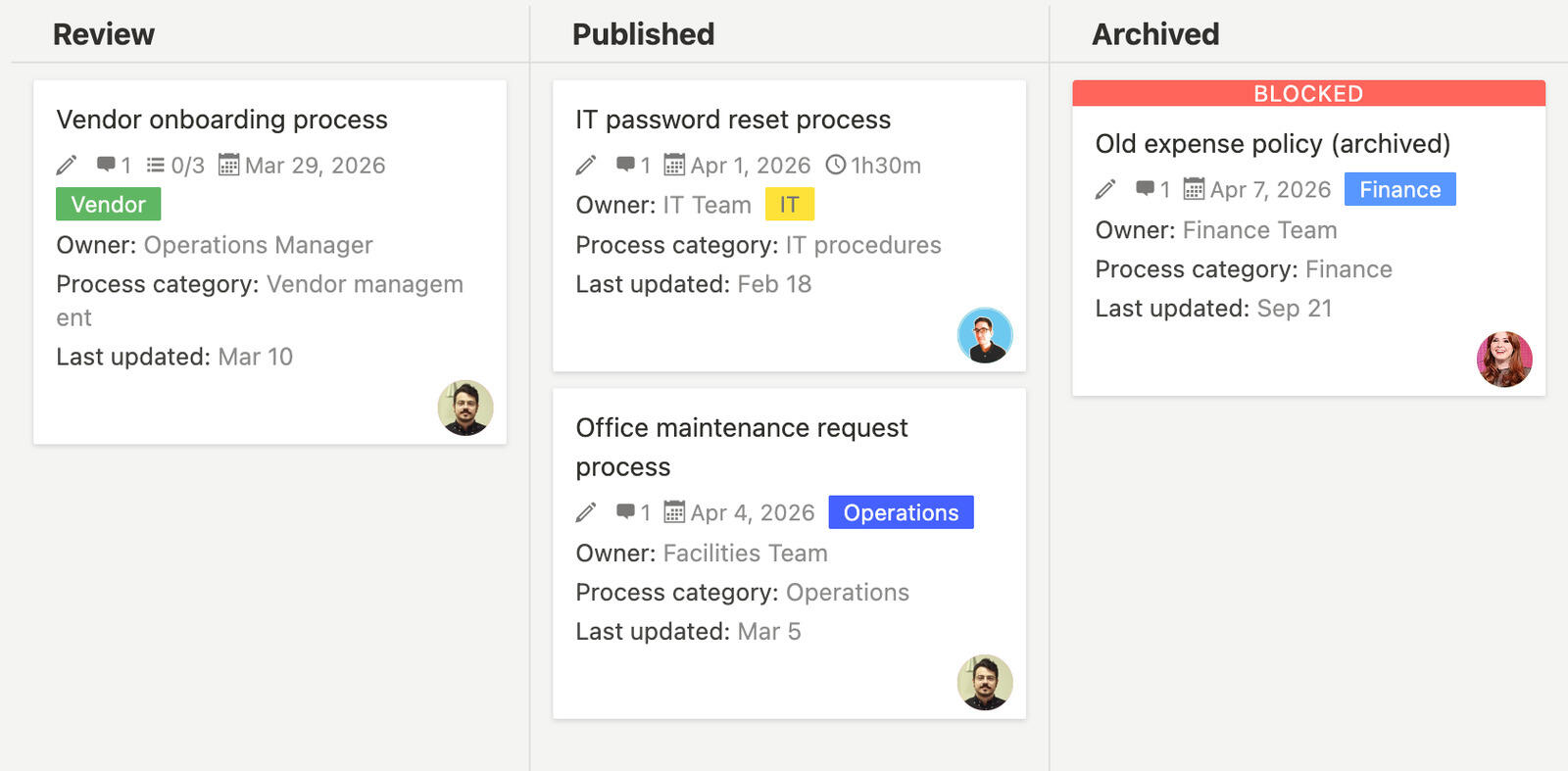
- Templates |
- Operations |
- Document internal processes for small teams
Internal processes template
Document internal processes for small teams. An internal processes template helps you centralize process documentation so team members can find and follow processes easily without searching through scattered documents.

Documenting internal processes means capturing everything from onboarding procedures and expense policies to vendor management and office protocols. Without a clear system, process documentation gets scattered across documents, team members can't find what they need, and processes become inconsistent. An internal processes template gives you a structure to centralize process documentation so team members can find and follow processes easily.
What is an internal processes template?
An internal processes template is a tool that helps you organize and document the processes your team uses to get work done. It gives you a structure to create process cards with steps, checklists, attachments, and links. The template helps you centralize process documentation in one place instead of scattered across documents, wikis, and email threads.
Using a template means you don't have to figure out the documentation structure each time. It reminds you to think about steps, checklists, and resources, and helps you stay organized even when you document many different processes.
Why do you need an internal processes template?
Documenting processes without organization means documentation gets scattered, team members can't find what they need, and processes become inconsistent. An internal processes template helps you maintain consistency and accessibility. Here's what it does:
- Centralized documentation keeps all processes in one place instead of scattered across documents and wikis
- Easy discovery helps team members find processes quickly without searching through multiple tools
- Consistent structure ensures every process follows the same documentation format
- Step-by-step guidance provides clear instructions that team members can follow
- Checklist support helps team members track progress through process steps
- Resource linking connects processes to related documents, forms, and tools
- Version control tracks changes to processes over time
- Accessibility makes processes available to everyone who needs them
- Onboarding support helps new team members learn processes quickly
- Process improvement makes it easier to update and refine processes
Without a template, process documentation often lives in scattered documents, wikis, or email threads, making it hard for team members to find what they need and follow processes consistently.
A static template is a good starting point, but using a project management tool like Breeze makes process documentation much more effective. With Breeze, you can centralize all processes in one place that everyone can access, organize processes by category with labels and stages, create process cards with steps, checklists, and attachments, link related processes and resources together, track process updates and versions, and make processes searchable so team members can find them quickly. Instead of managing process documentation through scattered documents, you get a centralized system that everyone can use.
What goes into an internal processes template?
An internal processes template should include sections for organizing all the different types of processes your team uses. Here's what typically goes into it:
- Process categories like onboarding, operations, finance, vendor management, or office protocols
- Process name - a clear title that describes what the process does
- Process description - an overview of when and why to use the process
- Step-by-step instructions that walk through the process from start to finish
- Checklists that match the steps so team members can track progress
- Attachments like forms, templates, or documents that team members need
- Related links to other processes, tools, or resources
- Owner information to show who maintains the process
- Last updated date to track when the process was last reviewed
- Status tracking to show whether processes are draft, review, published, or archived
Customize the template to match your team's needs. Add categories for the types of processes you document, adjust the structure based on your needs, and include fields that help your team find and follow processes more easily.
Frequently asked questions about internal processes templates
What types of processes should I document in the template?
You should document all types of internal processes in the template, including onboarding procedures, expense policies, vendor management processes, office protocols, IT procedures, and any other processes your team uses regularly. The template helps you organize these different types so team members can find and follow them easily.
How do you keep process documentation simple for small teams?
Use cards, checklists, and clear structure. Each process gets its own card with a clear name, description, and steps. Use checklists to break down steps into actionable items. Use labels to organize by category. Keep descriptions concise and focused on what team members need to know. The board makes processes easy to find and follow without overwhelming detail.
How do you make processes easy to find?
Use labels, stages, and search. Labels help organize by category - onboarding, operations, finance, vendor. Stages help organize by status - draft, review, published, archived. Search helps find processes by name or content. The board becomes a central place where team members can browse by category or search for specific processes.
How do you keep process documentation up to date?
Use comments, updates, and version tracking. When processes change, update the card with new steps or instructions. Add comments to explain changes. Use the last updated date to track when processes were reviewed. Move processes through stages - draft, review, published - to track the update process. The board makes it easy to see which processes need review and which are current.
How do you handle processes that are still being developed?
Use stages to track process status. Create cards for processes in development and move them through stages - Draft, Review, Published, Archived. Draft processes can be works in progress. Review processes can be ready for team feedback. Published processes are ready for use. The board shows which processes are ready and which are still being developed.




